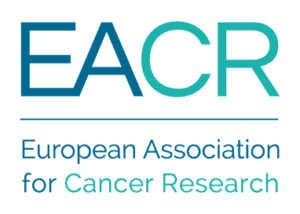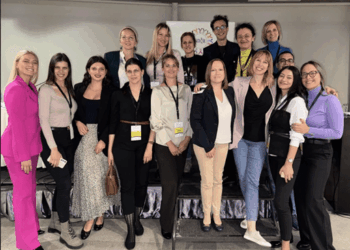Two of the biggest challenges for the treatment of most solid cancers are drug toxicity, particularly systemic toxicity, and drug permeation in the tumoral tissue. These obstacles may be mitigated through the development of intracellular delivery systems designed to selectively deliver drugs to the tumour.
In this episode, we discuss with Dr. Vishnu Raman, CSO and co-founder at Ernest Pharmaceuticals, the benefits and challenges of using genetically engineered Salmonella strains as a vector for the transport of therapeutic proteins into malignant cells. The focus will be on his recent publication in Molecular Therapy (10.1016/j.ymthe.2024.12.038), highlighted in a recent edition of the EACR’s Highlights in Cancer Research.
Listen here, scroll down for the transcript and subscribe now via Spotify, Apple Podcasts, Amazon Music/Audible, Deezer or YouTube so you’ll never miss an episode. You can find all episodes and their transcripts here.
Our host is Dr. Alexandra Boitor, EACR Scientific Officer.
Episode transcript
Alexandra: Hi Vishnu, and thank you so much for accepting our invitation to discuss your work on The Cancer Researcher Podcast.
Vishnu: Thanks, Alexandra. I’m thrilled to be able to talk about our work on this bacterial delivery platform.
Alexandra: This episode was inspired by your recent paper ‘Controlling intracellular protein delivery, tumour colonization and tissue distribution using flhDC in clinically relevant ΔsseJ Salmonella’ published at the end of last year, so in December 2024 if I’m not mistaken, in Molecular Therapy. This paper builds on many years of previous work performed in the Forbes lab, both on developing live vectors for drug delivery, but also on understanding how Salmonella strains colonise tumours.
So, before discussing the engineering details of your latest Salmonella vectors and the promising improvements they could bring to the clinic, I would like to give our listeners the opportunity to get familiar with some aspects of your previous work that brought you to the development of the ΔsseJ Salmonella strain.
So, could you please give us a bit of background on the use of bacteria in general and Salmonella in particular for cancer therapy?
Vishnu: Yeah. So it started just over a century ago, an oncologist by the name of William Coley observed a sarcoma patient who ended up having a spontaneous remission of their cancer when they ended up getting a streptococcus pyogenes infection. That made him curious as to how bacteria were enabling this. At the time he didn’t know it, but the immune system was a strong component of this bacteria mediated remission of the cancer.
So, when he saw that sarcoma patient tumour dissolved, he went through the records to figure out exactly what other conditions that patient had and that the strep bacteria that they were infected with, it was a skin infection, I believe, and he reconstituted that bacteria and heat killed the bacteria as what would be known as colitoxin. And he ended up, in subsequent patients, injecting that bacteria, or that heat killed bacteria, into the tumours and he saw mixed responses.
He did observe a few complete remissions but that method of treating cancer was also very toxic. It caused a lot of severe side effects. That was kind of the foundation of where the bacterial therapy field started. And seeing that bacteria could initiate an immune response to eliminate cancer.
And so fast forward several decades, Vion Pharmaceuticals and some of the really good work out of David Bermudes’ lab at Yale (Prof Bermudas is now at California State University, Northridge). He and colleagues created a strain of bacteria that was highly non-pathogenic. So, they were able to attenuate it in a way that it could be injected into the bloodstream, and it wouldn’t cause toxicity in the same way that any previous strain had. And so, this was a really big jump in the safety profile of any strain.
Unfortunately, that strain of bacteria, when it went into the clinic, they were relying purely on an immune response by the bacteria to create any sort of efficacy in the clinic.
So, give it another 20 years or so. A lot of people based off some of that early work, Professor Neil Forbes, has been working with Salmonella. And there are some other groups that have been working with other strains. Professor Tal Danino at Columbia has been extensively working with E coli, Professor Gravekamp (Albert Einstein College of Medicine), as well as professors Thomas Dubensky (now at ImmuneSensor Therapeutics) and Daniel Portnoy at Berkeley have been working with Listeria. Shibin Zhou at, Johns Hopkins has worked with Clostridium.
More recently, a group out of the University of Basel has worked with Yersinia. Simon Ittig and Christoph Kasper have worked to engineer a non-pathogenic strain of Yersinia to deliver immunotherapies in cancer. So, this field has expanded pretty rapidly within the past 10-20 years.
Why we chose Salmonella? So many people have chosen various strains. E coli is really good at delivering therapies extracellularly within tumours. Listeria is particularly effective at delivering immunotherapies within innate immune cells in tumours, to expose those immune cells to cancer antigens in order to generate an immune response against the tumours.
And why we chose Salmonella is uniquely because it has the ability to invade into any cancer cell without the need for it to bind to any receptor. So imagine a scenario where a doctor doesn’t know what receptors a tumour expresses within a patient. Without knowing that, the same strain of Salmonella can invade any solid cancer cell.
So, any cancer cell that’s within a solid tumour, VNP2R or any Salmonella strain that has SPI1 and SPI2 can invade into those cancer cells without the need for any receptor expression. And the reason why that is, is they make these needles. So they’re called type 3 secretion systems, and there’s two of them. So, the first one basically pokes a hole into the cancer cell, and it secretes effectors through this needle into the cancer cell. Those effectors force the cancer cell to actually rearrange their cytoskeleton and engulf the Salmonella intracellularly. And once that Salmonella is inside a cell, it actually resides in this small little vacuole, something very similar to an endosome. And then a second type 3 secretion system is used to modify that endosome in order for the bacteria to survive. So, what we did is we hijacked that natural system, that natural apparatus.
One of the most critical things from our early work is what we found were that the expression of flagella is actually one of the main drivers of this process of allowing Salmonella to invade cells. And the reason for that is because the flagella act as surface sensors. So, it allows the flagella to help sense a cell surface and attach to the cell so that, that type 3 secretion system 1 needle, can actually poke a hole into the cancer cell membrane. So that’s how flagella play a part in this, and we’ll get into that later.
The other really cool part is once the bacteria have internalised, they can sense this intracellular environment within that vacuole, through that T3SS2 system, so that second type 3 secretion system apparatus. And so, what we did is we actually hijacked that system. So, this is in our first publication in Nature Communications.
We hijacked that system, that intracellular sensing system, whereby the promoter that drives the sseJ gene is found within that T3SS2 system and that gets activated only inside the endosome or the bacteria in endosomes. And so, what we did is we put a suicide gene right in front of that promoter, so that when the bacteria get engulfed and go inside the endosome, instead of using that T3SS2 to reform the endosome and survive, as they would natively, they lyse, they just break open.
And because the bacteria no longer have the ability to maintain the endosome, because they’ve lysed, they no longer have the functional T3SS2 apparatus that maintains the function or the integrity of the endosome. The endosome dissolves, and whatever contents the bacteria we’re expressing, make their way into the cytoplasm where those therapies can have an effect.
That was the very first proof of concept, which was in our Nature Communications paper. This most recent publication in Molecular Therapy aimed to take all of those proof of concept mechanisms and convert them into something that could be usable in a clinical setting.
Alexandra: Do you want to go into a bit more detail regarding the changes that you’ve made to the vector?
Vishnu: Yeah, absolutely. One of the big things, as I said before, was that flagella are crucial for allowing the bacteria to enter into cancer cells. And so what we were wanting to do was make it so that we could control that process, for both safety and for efficacy purposes. And so one of the big problems early on in this field was when the early clinical trial was conducted with VNP2009, they noticed that tumour colonisation in humans was very inconsistent, it wasn’t quite what it was like in mice.
What they found was that there were likely certain ligands that bacteria express, flagella being one of them, that are readily recognised by the immune system and that facilitates rapid clearance from the blood. And so, what we wanted to do was control that process in such a way where the flagella are supressed when they’re injected to allow enough time for the bacteria to actually colonise tumours.
But then in tumours we wanted to induce flagella because that was what allowed the bacteria to deliver cancer therapies inside cancer cells. They needed to express flagella in order to actually deliver the therapy, but, at the time of injection, when the bacteria expressed flagella, we actually saw a 1 million-fold decrease in tumour colonisation. So, the timing of flagella expression was critical. And so, what we did is we put that flagella system, what we thought would be from a clinical standpoint, a practical way of inducing this.
And so, the idea here is the bacteria are grown up and injected in an aflagellate state. So, flhDC is the master regulator of flagella expression. And so, when they’re injected, they don’t express flhDC. But when the bacteria have cleared from systemic organ tissue, so, our strain is highly attenuated, and so in healthy organ tissue, the immune system is very functional. Because our strain is attenuated, the immune system has no problems clearing the bacteria from healthy organ tissue. So it’s rapidly cleared within a matter of six hours from healthy organ tissue. But once bacteria make their way into the tumour, because of that immunosuppressive environment, the bacteria grow exponentially. So, over the course of three days, one bacterium will become a hundred thousand up to a million.
When the bacteria are injected, they’re cleared from healthy organ tissue, and after about three to five days, when they reach maximal tumour colonisation, our idea was can we engineer the bacteria such that a patient could take an oral dose of aspirin, which is common, it’s an over the counter medicine that you can get at any drugstore? A simple over-the-counter dose of aspirin will then trigger the bacteria within the tumours to express flagella and then invade into cancer cells and deliver our therapy, which was caspase-3, inside cancer cells and initiate cell death.
So that was one of the most crucial switches that we added into our bug, this aspirin switch, because it did two things. It improved the safety of the strain. So, the bacteria went in attenuated, and they were rapidly cleared from healthy organ tissue. But once they made their way into the cancer, and only when they’re in the cancer, we have the ability to control their delivery so that no cytotoxic therapy can be delivered into healthy organ tissue.
So, the over the counter dose of aspirin basically allows the bacteria to only deliver a therapy in cancer cells in this way. That was a major switch that we put into our updated strain, amongst other things.
Alexandra: Thanks. And I don’t think we’ve discussed this but it might be somewhat relevant for my next question. So, the way that those bacteria find their way to the malignant tissue is through the leaky nature of the vasculature in the tumour. Right? And through the chemokine that the tumour, secretes and act as like chemoattractant to the bacteria. Am I right with this?
Vishnu: Yeah. So it’s a combination of those things. So because the tumour has chaotic vasculature, it tends to be a bit more permeable compared to other organ tissue. Some of Professor Forbes early work found that about one in 10,000 bacteria make their way into the tumour. So, for every 10,000 bacteria that’s injected about one will make their way into a tumour. They’ll specifically colonise some of these hypoxic areas and areas with tumour necrosis. There’s a couple reasons for this. For one, there are a lot of nutrients needed for the bacteria to survive there. But that is also a very immunoprivileged microenvironment.
So, the immune system doesn’t have the ability to clear bacteria out of those areas efficiently. And so those two things, when you couple them, that’s what allows the bacteria to grow exponentially, only within tumours. These same microenvironments are not found within healthy organ tissue, and so that’s why the immune system is able to rapidly clear them out of any healthy organ tissue.
Alexandra: That makes me wonder if cancer cells need to reside in a tumour for the Salmonella vector to be able to attack them, to put it that way, or whether the bacteria would be able to attack circulating tumour cells. I suppose you would have quite a few white blood cells in circulation, which might be a problem.
But on the other hand, the circulating tumour cells are already in the blood vessels, and as far as I know, they can also secrete chemokines. I’m not quite sure if the right type, though.
Vishnu: So we actually have not looked specifically at circulating tumour cells, but what we have looked at are metastases. Can our engineered strain colonise and deliver therapies into metastases? And so, what we found is that metastatic tumours have some of the same characteristics as primary tumours in terms of their microenvironment and our bacID delivery strain can actually colonise metastases as small as the width of a single human hair. So that’s around a hundred microns or so. We’ve seen this in both lung and liver metastases of breast cancer, which we’ve studied. And, moreover, we’ve seen that these bacteria can deliver therapies into metastatic lesions and reduce overall metastatic burden within the lung by about 85% and they also have exquisite selectivity only for the metastatic cancer cells within those two organs without harming any healthy tissue. And this is for the same reason that the bacteria also colonise primary tumours. It’s that very unique microenvironment that is not present in healthy tissue.
Alexandra: That’s great news that the Salmonella vector successfully reaches the metastatic sites as well. Your system addresses two of the biggest hurdles for the treatment of solid cancers, namely systemic toxicity and drug permeation in the tumoural tissue.
Another common culprit of anti-cancer therapies known to date is resistance to therapy. So do you foresee this as being a potential problem for your approach for BacID, both in terms of potential resistance being developed to the vector, but also to the recombinant protein that you’re using the constitutively active caspase-3.
Vishnu: At least in our work, we’ve actually delivered this constitutively active form of caspase-3, into cancer cells that express high levels of XIAP. So XIAP is the principle inhibitor of caspases and caspase-3.
We’ve actually seen very similar responses in both XIAP high and XIAP low tumour cells, which makes us think that cancer cells will not easily form resistance to our delivered therapy. And one of the reasons why we think this is, is the amount of caspase that’s actually produced natively by a cell that dies. So the way any cell dies is eventually caspase-3 and caspase-7 get activated and those proteins when activated execute the cell death program, the apoptotic cell death program.
But the amount that is needed of those two proteins, of caspase-3 and 7, are really low in order to actually initiate cell death. As few as 500 molecules, and we actually deliver two to three orders of magnitude more protein activated caspase-3 into a cancer cell compared to what is natively produced, just because the bacteria have the ability to express enough of it.
And so just because of the sheer amount of protein expressed, the cancer cells aren’t able to overcome the quantity of delivery, even if they express a lot of XIAP, it’s just because we can outcompete the inhibitor that they express.
Could this be a risk because it’s a highly potent apoptotic molecule? Is there an issue with non-specific delivery? Again, with active caspase-3 coupled to this ultra selective, BacID platform, we actually see colonization selectivity of up to 7 million bacteria in the tumour for one bacteria and healthy organ tissue.
So, for every one bacteria that you’d find in a healthy organ, you’ll find 7 million in the tumour. And moreover, as the immune system clears all of that bacteria from healthy organ tissue, really the only amount of BacID left is in the tumour. And so, when you give that dose of aspirin, it’s only the bacteria in the tumour that are activated to deliver the caspase-3, and healthy organ tissue is not harmed in any way.
We’ve actually seen that there’s absolutely no delivery of protein in healthy organ tissue. We only see delivery in the tumour. And so it’s the coupling of this highly potent cytotoxic agent with the ultra-specific BacID platform that makes this highly efficacious against tumours without having really any harsh side effects.
Alexandra: So, the developed vector and drug seem to be promising for a variety of cancers. I recall from the paper that among all the in vitro and in vivo experiments, you successfully tested this concept in pancreatic, breast, and liver cancer. It seems like a very promising approach to target a variety of solid tumours, particularly of advanced solid tumours given the ability of the vector to reach metastatic sites as well.
So, is there any sort of rule that dictates which type of tumours would be more likely to benefit from this approach?
Vishnu: For us we think any tumour that has a high unmet need, but that is also very heterogeneous, so that’s why liver cancer and pancreatic cancer are ideal candidates and that’s why we looked and tested our therapeutic approach against those two tumour types.
A lot of tumours, in order for conventional therapies to work, they have to have a pathway that is activated or they have to express a specific receptor in order for antibodies to target them. But there are a lot of cancers that have unique receptors that are not found in healthy organ tissue. So, it makes it really difficult to target some of these tumours. And then on top of that, some of the pathways in some of these cancer cells are mutated in a way where certain therapies just won’t work.
Our approach is more universal, so it can target any cancer regardless of the genetic characteristics. And it’s because the Salmonella strain that we use contains all of its own machinery to produce the drug and also to enter into a cancer cell and deliver the therapy.
It doesn’t require any receptor binding. Because again it has that T3SS1 needle that’s independent of any receptor, so it’s able to enter into a cancer cell all on its own. And then the suicide system that we’ve put into it, which allows the bacteria to lyse once they go inside cancer cells and deliver the therapy, that’s also a universal attribute, it does not depend on the cancer type.
And so, there are certain tumour types where if they don’t express specific receptors and there aren’t any existing therapeutic approaches for those, this approach could be really valuable in that way.
Another big part of it is we’ve intentionally delivered a cytotoxic agent. And one of the big reasons for this is a lot of other bacterial approaches try to rely on the immune system solely to create an anti-tumour immune response. Whereas what we’ve seen is that the cytotoxic response is really useful because when a cancer cell dies, it will release a lot of those neoantigens and neoantigens look foreign to the immune system.
But when a cancer cell is intact, obviously, some of those things aren’t as accessible to the innate immune system. So when you create this cancer cell death, some of these neoantigens, these tumour neoantigens, are released and coupled with some of the bacterial ligands like flagella, which are strongly immunogenic, those neoantigens get taken up by antigen presenting cells and they get cross presented to T cells, which then drive clearance of all of the non-infected tumour cells. And so, this is what really generates the durable response and the cure, but it’s really this coupling of cytotoxic response with the immunotherapeutic nature of the vector that really enhance the durable response that we see.
Alexandra: And what are the next steps or future directions you plan to pursue following these recent improvements to the BacID platform, particularly whether you see this being used in the clinic on its own, or whether you would see it being coupled with other therapies. Maybe a combination between immunotherapy and the use of this platform.
Vishnu: What we haven’t published is we’ve actually used this platform in combination with existing therapies, specifically with immunotherapies like checkpoint blockade and some of the other conventional chemotherapies. And found there to be a good synergy between them because they act in slightly different ways.
They still maintain the same tumour tropism and specificity and safety profile when combined with other therapies and so, kind of going off that, what we’re trying to do, we’re in the process of trying to start our IND enabling studies in order to actually put together an IND package so that we could start clinical trials.
Really the end impact here is to help patients where other therapies would not have an effect. I think this platform makes it so that patients that don’t express some of the common tumour types that are treated with some of the targeted therapies, or that are sensitive to conventional therapies, we think that our platform could have a real impact for those patients.
In addition to that, Professor Neil Forbes continues to expand the types of therapies that we are delivering with this platform, not only just with protein, but also DNA and RNA.
Alexandra: Sounds like you’ve got quite a few more experiments planned for the future.
Earlier in the conversation you mentioned that the vector is activated by a commonly used concentration of salicylic acid. A hot topic at the moment, at least in the UK, is the use of aspirin for cancer prevention. And aspirin is commonly used for the prevention and management of cardiovascular diseases as well. So, I was wondering if long-term use of aspirin could potentially affect the response to this type of therapy.
Vishnu: So, for us, aspirin was actually one of the most ideal candidates because it only has about a 12 hour half-life . And so, the long-term aspirin use doesn’t have any effect on the bacterial behaviour in vivo, and, if a patient were to take this therapy, they would just have to refrain from aspirin for a couple of days so that the aspirin concentration in their blood drops. And because the half-life of aspirin is fairly short, it wouldn’t be a prolonged withholding of aspirin. After a couple of days, once that aspirin concentration has dropped, when BacID is injected, there would be no effect. It would be as if somebody had never taken aspirin in the first place, so they’d be able to restart it a couple days after the injection, at least that’s what we would envision from a clinical standpoint.
But if certain patients require blood thinners for cardiovascular disease, there are a lot of other therapies or other common medicines that could be taken to achieve the same result for that short period of time.
Alexandra: It was lovely to chat with you, but unfortunately, we’re approaching the end of the episode. I would like to once again emphasise the versatility of BacID, the design vector, both in terms of efficacy against a broad range of advanced solid tumours, and also the potential to be used for the delivery of other recombinant proteins, subject to some more genetic manipulation.
And on that note, I’d like to thank you for taking the time to allow me and our listeners to take a glimpse into your research, and my last question would be if there’s anything else that you would like to add or like a particular thought that you would like to leave our audience with?
Vishnu: Yeah, so I’m really happy to see that bacterial cancer therapies have started to gain a lot of interest from a translational standpoint. So there’s been a lot of basic science and fundamental understanding of how these processes work, how bacteria specifically colonise tumours. And now with the advent of synthetic biology and our understanding of some of the intricate infection mechanisms of the bacteria, those two things I think will allow people to create really advanced bacterial therapies and help drive this field exponentially forward within the coming years.
Alexandra: Thank you very much for allowing us to learn more about your research and this out of the box approach to anti-cancer therapy.
Vishnu: Thank you very much, Alexandra. I appreciate the time.
Enjoyed it? Stay curious with The Cancer Researcher Podcast. Subscribe now via Spotify, Apple Podcasts, Amazon Music/Audible, Deezer or YouTube so you’ll never miss an episode. You can find all episodes and their transcripts here.
Suggest a topic for a future episode: What would you love to learn more about? Click here to give us your topic suggestions in a short online form. We warmly welcome your ideas and input!









